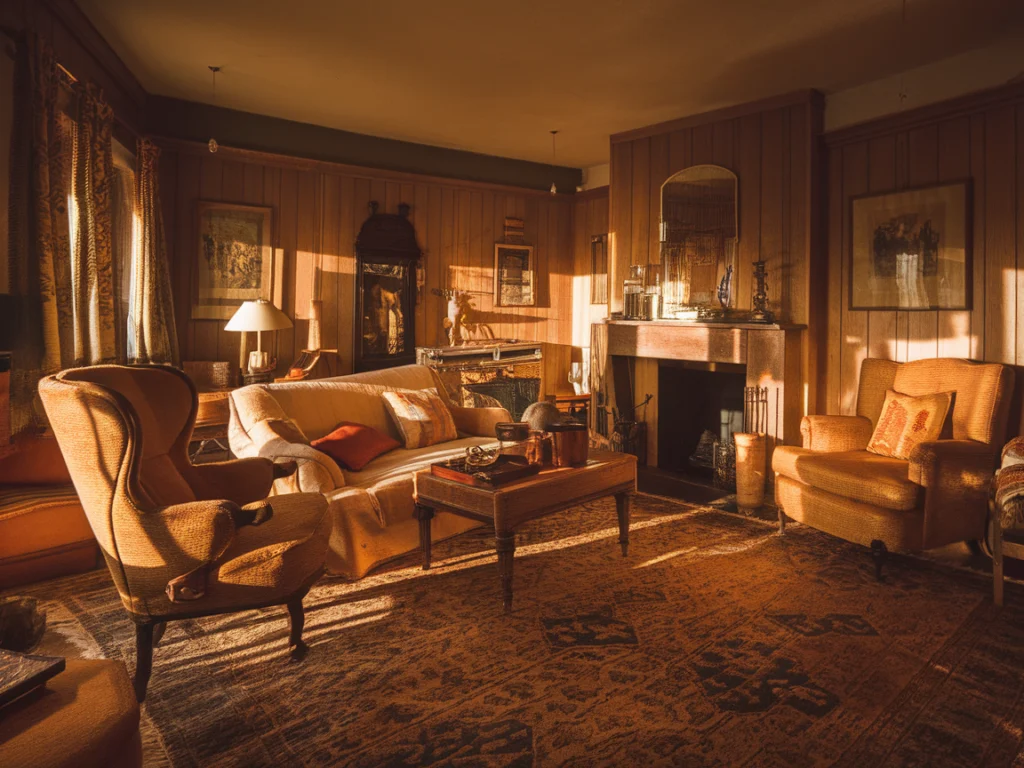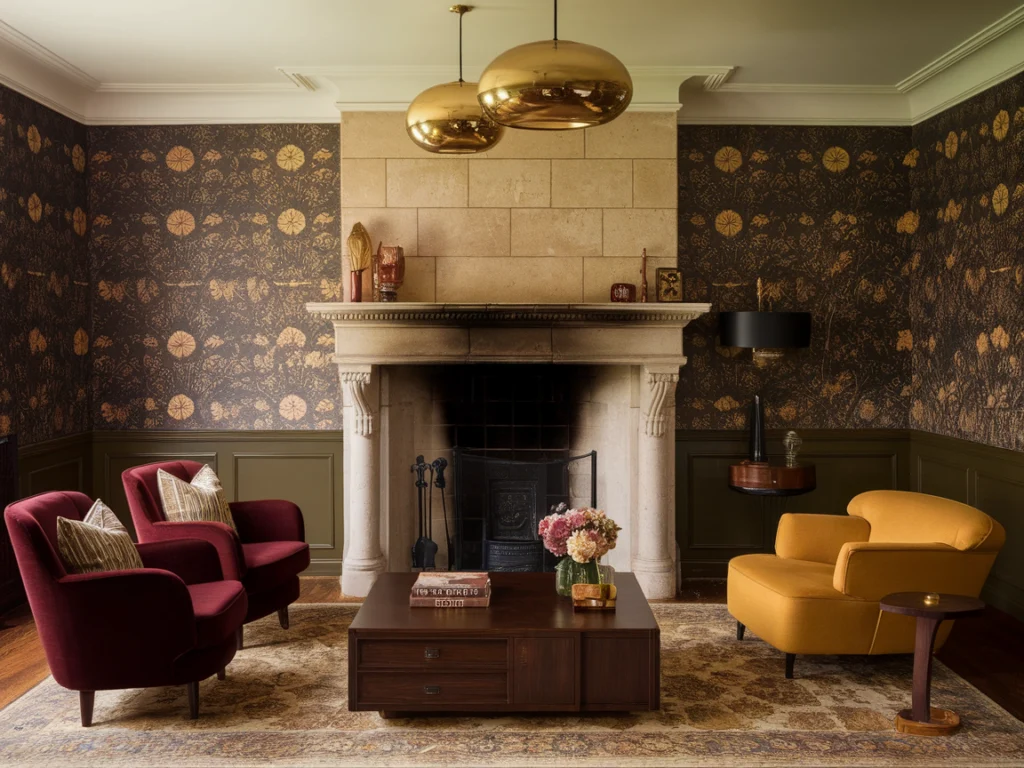Vintage Living Room Ideas: 7 Best Styles for 2025
Table of Contents
Introduction
Tired of scrolling through endless Pinterest boards filled with sterile, cookie-cutter living rooms that all look the same? You’re not alone. Today’s homeowners are craving spaces with personality, character, and stories to tell. Vintage living room ideas offer the perfect antidote to bland modern design, creating spaces that feel curated, sophisticated, and utterly unique.
These seven vintage styles will transform your living room into a space that guests will remember long after they leave. From the opulent glamour of Art Deco to the clean functionality of mid-century modern, each style brings its own charm and character to contemporary homes.
As an interior design consultant who has helped over 200 families create stunning vintage-inspired spaces over the past decade, I’ve seen firsthand how the right vintage elements can completely transform a room’s energy and appeal. The key lies in understanding what makes each era special and how to adapt those elements for modern living.
In this guide, we’ll explore the seven most popular vintage styles dominating 2025, covering everything from signature furniture pieces and color palettes to styling tips and budget-friendly shopping strategies. You’ll discover how to choose the perfect vintage style for your space, where to find authentic pieces, and how to blend vintage charm with contemporary comfort.
Why These Vintage Living Room Ideas Work
The resurgence of vintage design isn’t just a passing trend—it’s a response to our increasingly fast-paced, digital world. Vintage living room ideas are capturing hearts across America for good reason.
These styles offer timeless appeal that never goes out of fashion. Unlike trendy design movements that feel dated within years, vintage styles have proven their staying power across decades.
Vintage furniture also provides superior craftsmanship and materials. These pieces were built to last, featuring solid wood construction and quality hardware rarely found in mass-produced modern furniture.
Most importantly, vintage pieces bring unique character that reflects your personality. They tell stories and create conversation starters, making your living room feel personal rather than catalog-perfect.
• Sustainable and eco-friendly approach: Choosing vintage means giving new life to existing pieces rather than contributing to furniture waste • Budget-friendly options for every homeowner: From thrift store finds to estate sale treasures, vintage style can be achieved at any price point • Versatile enough for any home size: Whether you live in a studio apartment or sprawling suburban home, vintage elements can be scaled to fit your space perfectly
Choosing the Right Vintage Style
Selecting the perfect vintage style for your living room requires understanding both your personal preferences and your home’s architecture. Not every vintage era will work in every space, and the most successful vintage rooms reflect thoughtful consideration of these factors.
Best Styles for Different Home Types
Victorian (1837-1901) works beautifully in older homes with high ceilings, crown molding, and architectural details. The ornate furniture and rich fabrics complement traditional home features without overwhelming smaller spaces.
Art Deco (1920s-1930s) shines in urban apartments and homes with clean architectural lines. The geometric patterns and metallic accents add glamour without requiring extensive architectural modifications.
Mid-Century Modern (1940s-1960s) adapts to virtually any home style, making it the most versatile choice. The clean lines and functional focus work especially well in contemporary homes and open floor plans.
Matching Your Lifestyle
Consider how you actually use your living room. Families with young children might gravitate toward mid-century modern’s durable materials and easy-to-clean surfaces, while empty nesters might enjoy the formal elegance of Victorian or Art Deco styling.
Active households benefit from vintage styles that prioritize function alongside beauty. Mid-century modern and 1970s casual styles offer comfortable seating and practical storage solutions.
Frequent entertainers might prefer the sophisticated glamour of Art Deco or the cozy charm of 1940s traditional style, both of which create impressive backdrops for dinner parties and gatherings.

Substitutions and Adaptations
Don’t feel locked into rigid historical accuracy. The best vintage rooms blend elements from different eras while maintaining a cohesive overall aesthetic. You might combine a 1960s sectional sofa with 1920s accent tables, or pair Victorian wallpaper with mid-century lighting fixtures.
The 7 Best Vintage Styles for 2025
Style 1: Victorian Elegance (1837-1901)
Key Elements:
- Rich, dark wood furniture with ornate carvings
- Jewel-tone color palettes (burgundy, forest green, deep purple)
- Layered textiles including velvet, brocade, and fringe details
- Crystal chandeliers and ornate table lamps
- Persian or Oriental rugs with intricate patterns
Signature Pieces: Tufted Chesterfield sofas, carved wooden side tables, ornate picture frames, heavy drapery with tasseled tiebacks
Modern Adaptations: Use Victorian-inspired furniture in lighter woods, incorporate jewel tones through accent pieces rather than overwhelming wall colors, choose one ornate focal piece per room to avoid visual chaos
Style 2: Art Deco Glamour (1920s-1930s)
Key Elements:
- Geometric patterns and angular furniture lines
- Metallic accents in gold, silver, and chrome
- Bold color contrasts (black and white with jewel tone accents)
- Mirrored surfaces and reflective materials
- Sunburst mirrors and stepped architectural details
Signature Pieces: Chrome and glass coffee tables, geometric area rugs, bar carts with metallic finishes, stepped bookcases, dramatic floor lamps
Modern Adaptations: Incorporate geometric patterns through throw pillows and artwork, use metallic accents sparingly to avoid overwhelming the space, choose reproduction pieces that offer modern comfort with authentic styling
Style 3: Mid-Century Modern (1940s-1960s)
Key Elements:
- Clean lines and minimal ornamentation
- Warm wood tones (walnut, teak, rosewood)
- Bold geometric patterns in muted color palettes
- Low-profile furniture with tapered legs
- Integration of natural materials and organic shapes
Signature Pieces: Eames chairs, boomerang coffee tables, credenzas with sliding doors, atomic-inspired light fixtures, abstract artwork
Modern Adaptations: Mix authentic vintage pieces with high-quality reproductions, incorporate bold patterns through textiles rather than furniture, balance warm wood tones with contemporary neutral backgrounds
Style 4: 1970s Bohemian (1970s)
Key Elements:
- Earth tone color palettes (burnt orange, avocado green, golden yellow)
- Natural materials like rattan, macrame, and shag textures
- Low seating arrangements and floor cushions
- Plants and natural elements throughout the space
- Handcrafted and artisanal decorative pieces
Signature Pieces: Sectional sofas in earth tones, hanging macrame planters, rattan peacock chairs, shag area rugs, ceramic pottery in organic shapes
Modern Adaptations: Use 1970s colors as accents rather than dominant themes, incorporate natural textures through throw pillows and wall hangings, balance bohemian elements with cleaner modern pieces
Style 5: 1940s Traditional (1940s)
Key Elements:
- Comfortable, family-focused furniture arrangements
- Floral patterns and feminine color palettes
- Mix of formal and casual elements
- Quality craftsmanship with practical functionality
- Patriotic colors and motifs reflecting wartime influences
Signature Pieces: Floral chintz sofas, wooden coffee tables with curved edges, table lamps with fabric shades, framed family photographs, cozy reading chairs
Modern Adaptations: Choose floral patterns in updated color schemes, focus on comfort and functionality over formal presentation, incorporate family heirlooms and personal collections
Style 6: 1980s Postmodern (1980s)
Key Elements:
- Bold color combinations and geometric shapes
- Memphis Group-inspired furniture with unusual proportions
- Mix of high-end and mass-market design elements
- Neon accents and metallic finishes
- Eclectic combinations of patterns and textures
Signature Pieces: Modular seating systems, glass-top tables with colorful bases, geometric area rugs, bold artwork, metallic accent pieces
Modern Adaptations: Use 1980s elements as accent pieces rather than dominant themes, incorporate bold colors through easily changeable accessories, balance eclectic elements with neutral backgrounds
Style 7: French Country Vintage (Various Eras)
Key Elements:
- Distressed and weathered furniture finishes
- Soft, romantic color palettes (cream, soft blue, lavender)
- Natural materials like linen and cotton
- Floral patterns and toile fabrics
- Antique and vintage accessories with patina
Signature Pieces: Slipcovered sofas, distressed wooden coffee tables, vintage French mirrors, ceramic pitchers and bowls, linen window treatments
Modern Adaptations: Achieve distressed looks through painting techniques rather than authentic aging, incorporate French elements through textiles and accessories, balance romantic elements with contemporary comfort
Pro Tips for Perfect Vintage Living Rooms
Avoiding Common Vintage Decorating Mistakes
Don’t create a museum: The biggest mistake homeowners make is trying to recreate a perfect period room. Instead, focus on capturing the spirit of your chosen era while accommodating modern needs and personal preferences.
Avoid overcrowding: Vintage furniture tends to be substantial and visually heavy. Give pieces room to breathe by leaving adequate space between furniture groupings and choosing a few statement pieces rather than filling every corner.
Balance authenticity with comfort: While authentic vintage pieces add character, don’t sacrifice functionality for historical accuracy. Your living room should serve your family’s daily needs first and foremost.
Essential Tools and Resources
Quality reproduction sources: Companies like West Elm, CB2, and Article offer well-made vintage-inspired pieces at accessible price points. For higher-end reproductions, consider Herman Miller, Knoll, and Design Within Reach.
Authentication resources: Learn to identify authentic vintage pieces through maker’s marks, construction techniques, and design details. Books like “Miller’s 20th Century Design” provide valuable reference information.
Professional refinishing services: Find local furniture restorers who specialize in vintage pieces. Professional refinishing can transform damaged authentic pieces into stunning focal points.
Storage and Maintenance
Proper care for vintage textiles: Store vintage fabrics away from direct sunlight, use acid-free tissue paper for folding, and have valuable pieces professionally cleaned rather than attempting DIY methods.
Furniture preservation: Use coasters and table pads to protect vintage wood surfaces, avoid placing vintage pieces near heating vents or in direct sunlight, and address minor repairs promptly to prevent further damage.
Documentation and insurance: Photograph your vintage pieces and keep records of purchase prices and provenance. Consider adding valuable vintage furniture to your homeowner’s insurance policy.
Budget-Friendly Vintage Style Variations
Creating stunning vintage living room ideas doesn’t require unlimited funds or access to high-end antique dealers. With creativity and strategic shopping, you can achieve authentic vintage style at virtually any budget level.
Thrift Store and Estate Sale Strategy
Timing is everything: Shop estate sales on the final day for the best prices, visit thrift stores on weekdays when competition is lower, and build relationships with shop owners who can alert you to incoming pieces.
DIY vintage transformations: Learn basic furniture refinishing techniques to transform damaged pieces into vintage treasures. Simple updates like new hardware, fresh paint, or reupholstering can completely change a piece’s appearance.
Reproduction and vintage-inspired options: When authentic pieces are out of reach, high-quality reproductions can provide the same visual impact. Focus your budget on one or two authentic statement pieces and supplement with carefully chosen reproductions.
High-Impact, Low-Cost Updates
Vintage-inspired paint colors: Transform any room with historically accurate paint colors. Benjamin Moore and Sherwin Williams both offer curated vintage color collections that capture the essence of different eras.
Thrift store accessories: Vintage lamps, artwork, and decorative objects are often available at fraction of their retail cost. Focus on pieces with good bones that can be updated with new lampshades or minor repairs.
DIY textile projects: Sew your own throw pillows using vintage-inspired fabrics, create window treatments that echo your chosen era’s style, or reupholster small pieces like dining chairs or ottomans.
Styling Your Vintage Living Room
The difference between a cluttered antique shop and an elegant vintage living room lies in thoughtful styling and curation. Here’s how to pull together your vintage elements into a cohesive, livable space.

Creating Balanced Vignettes
The rule of threes: Group decorative objects in odd numbers for the most pleasing visual arrangements. Vary heights, textures, and shapes within each grouping to create interest without chaos.
Layering and depth: Create visual depth by layering objects at different heights and distances from the wall. Use books, small boxes, or decorative stands to create varied elevations within your displays.
Color coordination: Even eclectic vintage collections benefit from some color coordination. Choose a palette of 3-4 colors that appear throughout your vintage pieces and use these as your unifying thread.
Mixing Vintage with Contemporary
70/30 rule: For the most successful blend, aim for approximately 70% vintage elements with 30% contemporary pieces, or vice versa depending on your preference. This ratio prevents either style from overwhelming the other.
Bridge pieces: Use transitional elements that work with both vintage and contemporary styles. Natural materials like wood, metal, and stone often serve as excellent bridges between different eras.
Modern comfort, vintage style: Invest in contemporary pieces that provide superior comfort while maintaining vintage aesthetics. A modern sofa in a vintage-inspired fabric gives you the best of both worlds.
Frequently Asked Questions
Can I mix different vintage eras in one room?
Absolutely! The most interesting vintage rooms often combine elements from different eras. The key is maintaining some unifying elements—whether through color palette, material choices, or overall style sensibility. Start with one era as your foundation, then selectively incorporate pieces from adjacent time periods.
How do I make vintage furniture work with modern technology?
Modern technology integration requires creative solutions. Look for vintage entertainment centers that can house modern equipment, use decorative boxes or baskets to hide cables and remotes, and consider wireless technology when possible to reduce visible cords. Many vintage pieces can be retrofitted with modern functionality while maintaining their authentic appearance.
Is vintage style safe for families with young children?
With thoughtful selection, vintage style can absolutely work for families. Choose vintage pieces with rounded edges over sharp corners, opt for performance fabrics that can withstand spills and wear, and avoid delicate accessories at child height. Many vintage styles, particularly mid-century modern, were designed with family functionality in mind.
How much should I budget for a vintage living room makeover?
Vintage style can be achieved at virtually any budget level. A basic refresh using paint, accessories, and one or two key vintage pieces might cost $1,000-3,000, while a complete room transformation with authentic vintage furniture could range from $5,000-15,000 or more. Start with a clear budget and prioritize your must-have elements.
Where can I find authentic vintage pieces?
The best sources include estate sales, antique shops, online marketplaces like Chairish and 1stDibs, local classified ads, and specialty vintage furniture stores. Building relationships with dealers and shop owners can lead to first access to incoming pieces. Don’t overlook family heirlooms, which often provide the most meaningful vintage elements.
Conclusion
Vintage living room ideas offer an incredible opportunity to create spaces with personality, character, and timeless appeal. Whether you’re drawn to the ornate elegance of Victorian style, the geometric glamour of Art Deco, or the clean functionality of mid-century modern, each vintage era brings its own unique charm to contemporary homes.
The seven styles we’ve explored represent the most popular and adaptable vintage aesthetics for 2025, each offering different benefits for different lifestyles and home types. Remember that the most successful vintage rooms balance authenticity with modern comfort, creating spaces that honor the past while serving present-day needs.
Start your vintage journey today by choosing one style that speaks to you, then begin collecting pieces gradually. Visit local estate sales this weekend, browse online vintage marketplaces, or simply start with vintage-inspired paint colors to test the waters.
Join thousands of homeowners who have discovered the joy of vintage style—spaces that feel collected rather than decorated, meaningful rather than trendy, and utterly unique to your personal story. Your perfect vintage living room awaits, ready to become the heart of your home for years to come.
Ready to dive deeper into vintage design? Explore our complete guide to “Mid-Century Modern Furniture: Authentication and Buying Tips” and discover “Victorian Color Palettes: Modern Applications for Historic Charm” to continue your vintage design journey!

